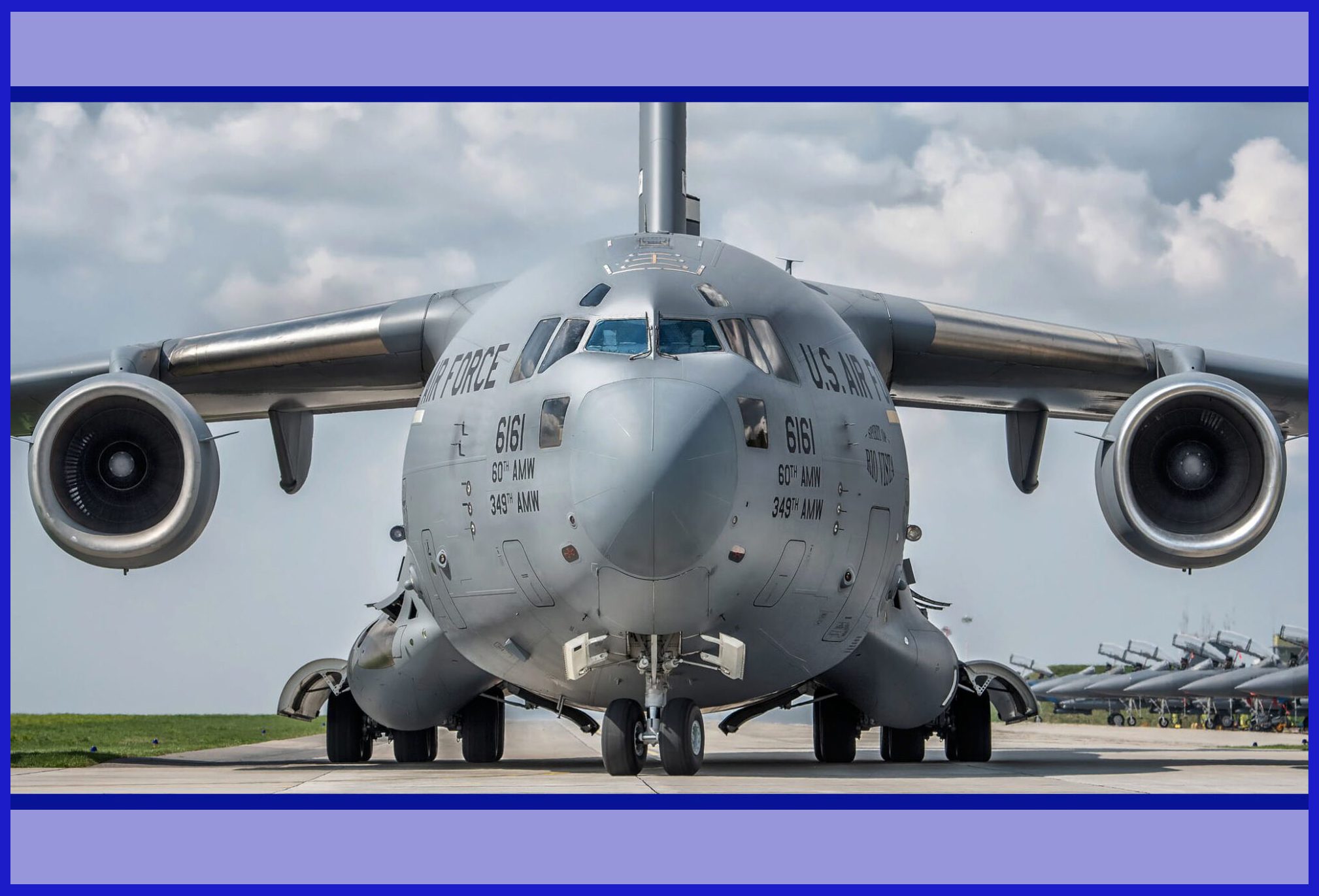Introducing a colossal workhorse of the skies, Let’s Explore The Boeing Globemaster III. The multi-service C-17 Globemaster, distinguished by its high-wing configuration, four potent engines, and distinctive T-tail design, emerges as a formidable military transport aircraft. It possesses the remarkable ability to take off directly from small airfields nestled within challenging terrains, facilitating the efficient transportation of troops, supplies, and heavy equipment.
This enormous and resilient long-haul airplane excels at traversing significant distances, reaching diverse destinations, and managing substantial, oversized payloads even amidst unpredictable weather conditions. Serving as a pivotal asset in logistics and humanitarian endeavours, this large military transport aircraft plays a vital role. It operates alongside the United States Air Force and the air forces of various nations, including India, the UK, Australia, Canada, Qatar, the United Arab Emirates, and Kuwait.
The Globemaster III has been used in a variety of missions, including supporting military operations in Afghanistan and Iraq, where it was crucial for transporting troops and equipment. It has also been used in disaster relief efforts, such as delivering supplies to Haiti after the 2010 earthquake and providing aid following the 2011 Sindh floods.
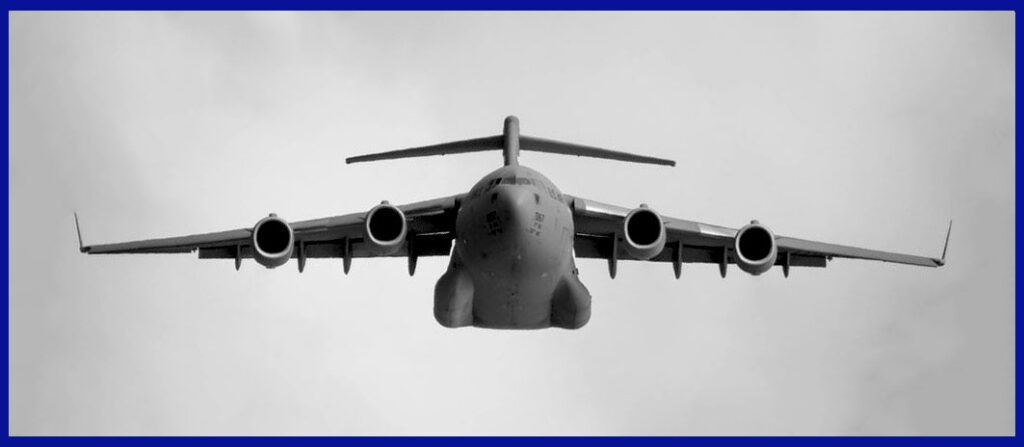
The YC-15, a more compact prototype airlifter created in the 1970s, served as the foundation for the C-17. It was created to take over the roles of both the Lockheed C-5 Galaxy and the Lockheed C-141 Starlifter. The modified airlifter was different from the YC-15 in that it had sweeping wings, a larger size, and more potent engines. A number of design problems delayed development, which cost the business roughly US$1.5 billion in lost revenue throughout the program’s development phase.
The first C-17 made its maiden flight on September 15, 1991, about a year later than planned. On January 17, 1995, the C-17 was formally accepted into the USAF service. The C-17 was still being produced by Boeing when it merged with McDonnell Douglas in 1997. At the Long Beach, California factory, the last C-17 was finished and launched on November 29, 2015.
Design and Development Phases of the C-17 Globemaster III
The C-17 Globemaster III, a substantial military transport aircraft, was conceived and developed by the American aerospace corporation McDonnell Douglas, now amalgamated with Boeing. The inception of the C-17’s design is traced back to the YC-15, a prototype aircraft formulated during the 1970s with a parallel purpose. Engineered to fulfil the United States Air Force’s (USAF) requisites, the YC-15 was crafted as a tactical airlifter proficient in operating from compact, undeveloped runways while effectively accommodating substantial cargo loads.
The USAF was impressed with the performance of the YC-15 but requested several changes for the new aircraft to better meet their needs. The redesigned C-17 had more powerful engines, a larger size, and swept wings that improved its lift and range capabilities. It was also designed to perform a wider range of tasks than the YC-15, including carrying vehicles, troops, and other cargo.
The development phase of the C-17 was prolonged due to a series of design issues and technical challenges that McDonnell Douglas faced. The development cost of the aircraft exceeded its original budget, leading to financial losses for the company. However, the USAF continued to support the program due to its strategic importance, and the C-17 eventually entered service in 1995. Today, the C-17 remains a vital part of the USAF’s airlift fleet and has also been used by several other countries for military and humanitarian missions.
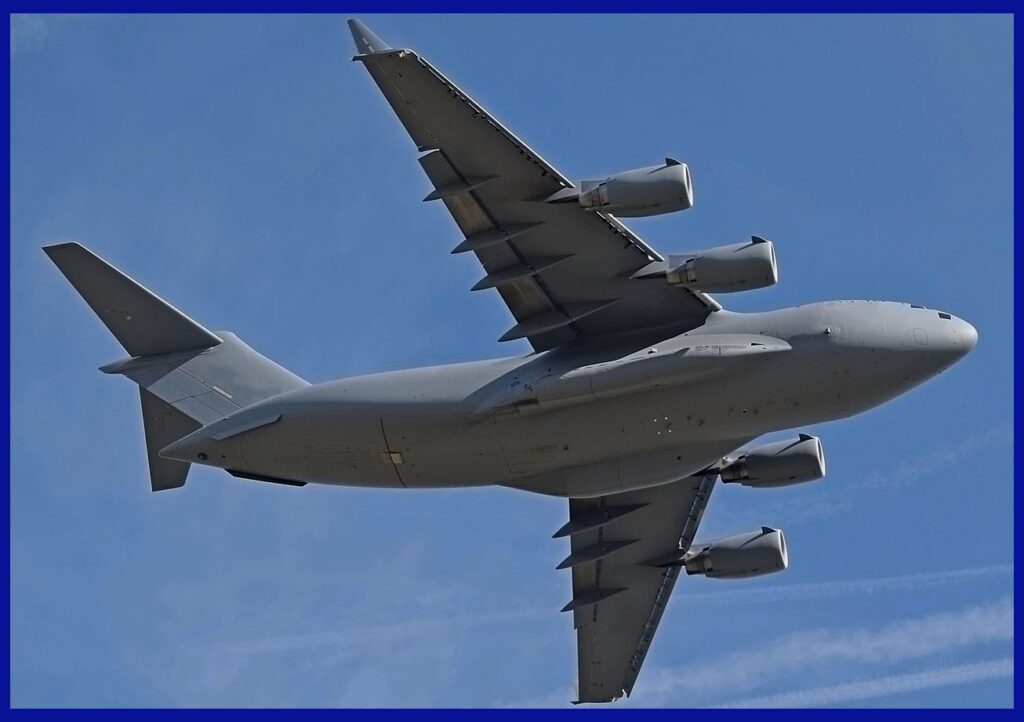
Manufacturing and Deliveries of the C-17 Globemaster III
In 1996, the Department of Defense (DoD) ordered a total of 120 C-17 Globemaster aircraft. The following year, McDonnell Douglas merged with domestic competitor Boeing. In April 1999, Boeing proposed a lower unit price for the C-17 if the USAF agreed to purchase an additional 60 aircraft. Later, in August 2002, the order was increased to a total of 180 aircraft. By 2007, 190 C-17s had been ordered for the USAF.
In 2009, Boeing was awarded a $2.95 billion contract to produce 15 more C-17s, bringing the total USAF fleet to 205 and extending production from August 2009 to August 2010. However, on April 6th, 2009, U.S. Secretary of Defense Robert Gates announced that the USAF would not order any more C-17s beyond the planned 205.
In 2010, due to a decrease in orders, Boeing reduced the production rate of the C-17 Globemaster from 16 to 10 aircraft per year. This move was aimed at extending the production line’s lifespan while the company sought additional orders. As a result, about 1,100 jobs were cut through 2012, and a second shift at the Long Beach plant was eliminated.
As of April 2011, 230 C-17 production aircraft had been delivered, with 210 going to the USAF. The C-17 prototype, known as “T-1”, was retired in 2012 after being used as a testbed by the USAF. In January 2010, the USAF announced that Boeing’s performance-based logistics contracts to maintain the type would end soon.
On June 19th, 2012, the USAF ordered its 224th and final C-17 to replace one that crashed in Alaska in July 2010.
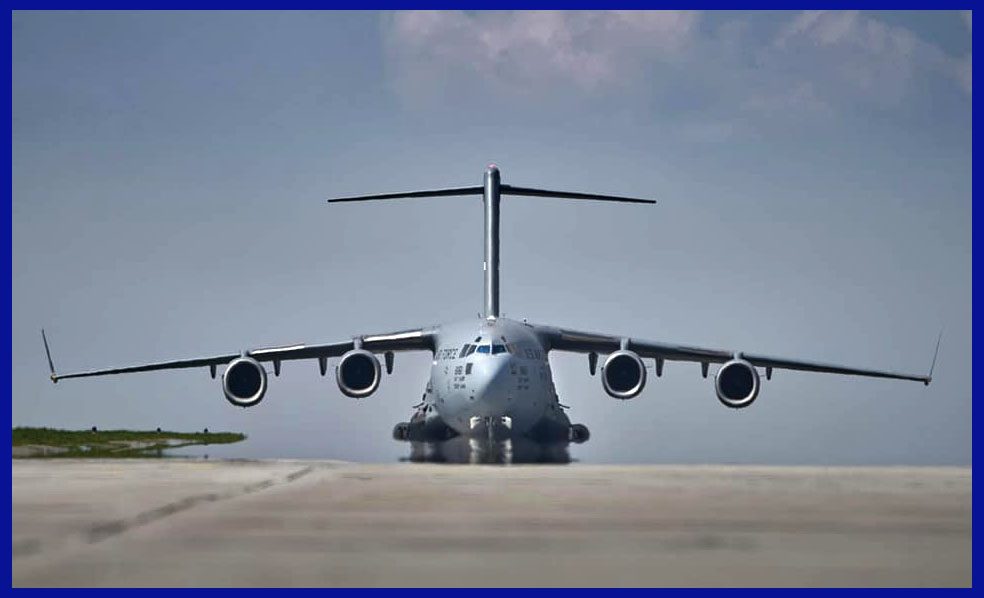
The Design Analysis of the C-17 Globemaster III
The C-17 Globemaster III serves as a pivotal strategic transport aircraft, uniquely equipped for the aerial transportation of cargo in proximity to conflict zones. Driven by escalating air mobility demands, particularly concerning sizable or weighty non-palletized oversized loads, the dimensions and mass of U.S. mechanized firepower and equipment have experienced notable growth over recent decades. Approximately 8% of its composition comprises composite materials, predominantly within the secondary structure and control surfaces. In terms of measurements, the aircraft extends to a length of 174 feet (53 meters) and spans 169 feet 10 inches (51.77 meters) in width.
The C-17 employs four Pratt & Whitney F117-PW-100 turbofan engines, drawing from the commercial Pratt & Whitney PW2040 engine used in Boeing 757 aircraft. Each engine boasts a potent thrust of 40,400 pounds (equivalent to 180 kN). Strategically positioned exhaust air redirectors on the engines redirect exhaust air upwards and forwards, effectively countering the risk of debris ingestion and foreign object damage during runway activities. This arrangement also generates a substantial reverse force, aiding aircraft lift during taxiing. Additionally, thrust reversers can be utilized during idle-reverse flight to heighten drag during rapid descents. Notably, vortex surfing tests on two C-17s showcased an impressive fuel efficiency boost of up to 10% under these conditions.
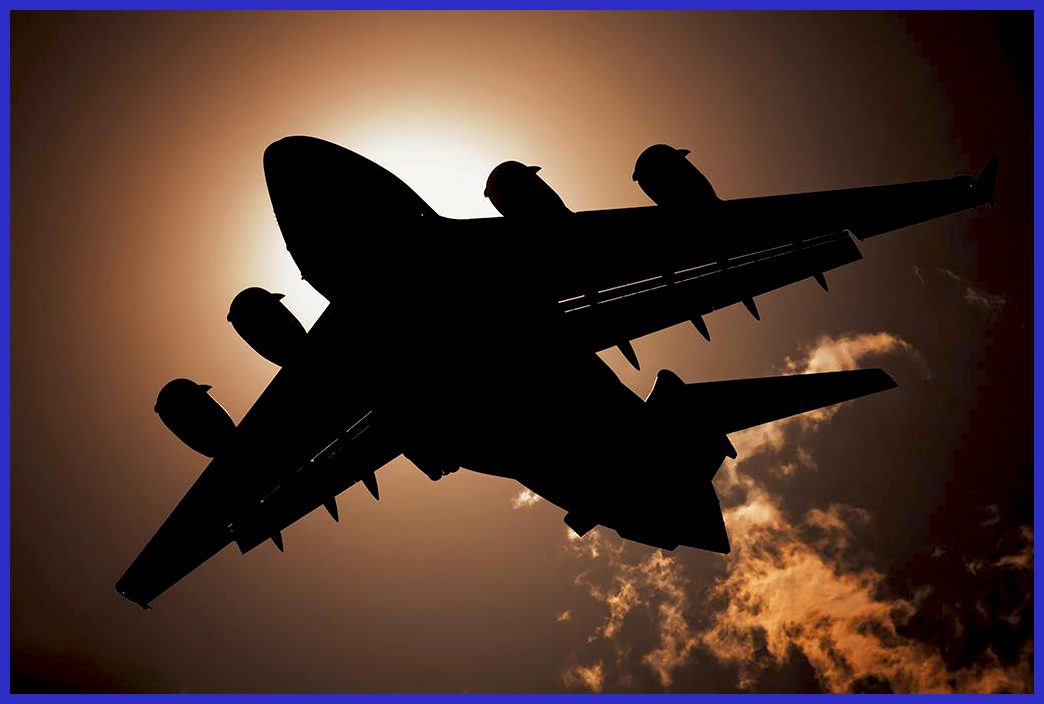
A three-person crew is needed for C-17 cargo operations
A pilot, a copilot, and a loadmaster. The cargo area is 18 feet (5.5 m) wide, 88 feet (27 m) long, and 12 feet 4 inches (3.76 m) high. The cargo floor can be turned over to create a level surface appropriate for automobiles and other rolling stock. The cargo floor contains rollers for palletized items. A sizable aft ramp is used to load goods, and it can handle rolling stock like a 69-ton (63-metric-ton) M1 Abrams main combat tank, other armoured vehicles, trucks, and trailers, as well as palletized cargo.
The C-17 boasts an impressive capacity, capable of accommodating payloads of up to 170,900 pounds (77,500 kg) and lifting a remarkable maximum of 585,000 pounds (265,000 kg) into the sky. With a payload capability of 160,000 pounds (73,000 kg) and a cruising altitude set at 28,000 feet (8,500 meters), the aircraft encompasses an unrefueled range of approximately 2,400 nautical miles (4,400 kilometres) for the initial 71 aircraft, expanding to 2,800 nautical miles (5,200 kilometres) for subsequently produced extended-range models. An innovative feature includes a sealed centre wing bay, ingeniously serving as an additional fuel tank to further enhance operational endurance.
The C-17 is built to fly on runways as narrow as 90 feet ( 27 meters ) and as short as 3,500 feet ( 1,100 meters ). Runways that are not paved or renovated can be used by the C-17. On constrained taxiways, a three- ( or more ) point turn can be made with the thrust reversers to propel the aircraft backwards and in the opposite direction. The aircraft is intended for a 74% mission availability rate and 20 man-hours of maintenance per flight hour.
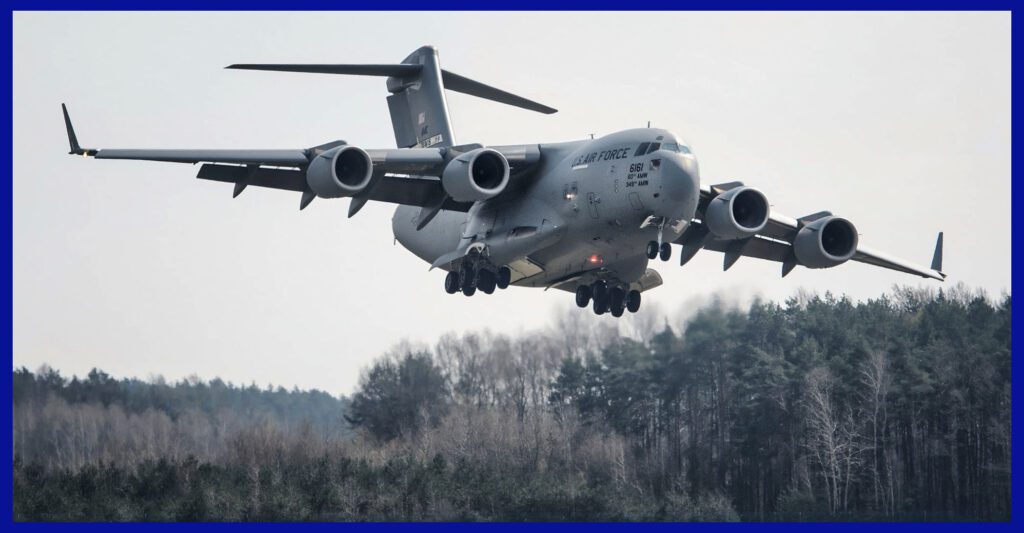
Quick Facts about the C-17 Globemaster III
- Take off from a 7,740-foot ( 2359.15-meter ) airfield
- Carry a payload of up to 164,900 lb ( 74,797 kg )
- Fly 6,230 nautical miles with no payload
- It can Refuel while in flight
- Land in 3,000 ft ( 914 m ) or less on a small unpaved or paved airfield day or night.
- Carry a cargo of wheeled U.S. Army vehicles in two side-by-side rows, including the U.S. Army’s main battle tank, the M-1
- Drop a single 60,000-lb ( 27,216-kg ) payload, with sequential load drops of 110,000 lb ( 49,895 kg )
Operational History of the C-17 Globemaster III
The C-17 Globemaster has a distinguished operational history. Its first major deployment was during NATO’s Operation Allied Force in 1999, where it was used to drop supplies and troops in Kosovo. In 2001, C-17s were deployed to Afghanistan to support Operation Enduring Freedom, where they carried troops, supplies, and equipment.
During the Iraq War, C-17s played a crucial role in transporting troops and cargo into the country. They also evacuated wounded soldiers and brought supplies into remote areas. In 2005, C-17s were used in relief efforts following Hurricane Katrina, where they airlifted supplies and equipment to the affected areas.
C-17s have also been used in humanitarian missions, such as delivering aid to earthquake victims in Pakistan and Haiti. In addition, they have been used to transport dignitaries and VIPs, including U.S. presidents, and have participated in various airshows and exhibitions around the world.
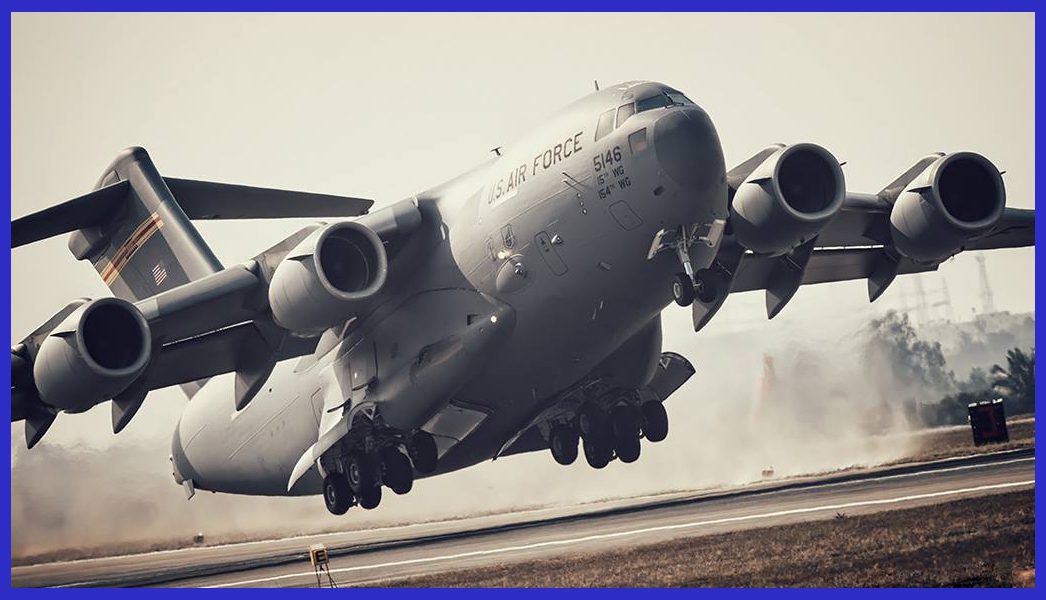
Here are some additional pieces of information about the operational history of the C-17 Globemaster
- The C-17 has been used for a variety of military operations, including peacekeeping missions in the Balkans, combat operations in Iraq and Afghanistan, and humanitarian missions in Africa and Asia.
- In 2003, during the Iraq War, a C-17 set a record by carrying the heaviest single payload ever transported by air, weighing over 170,000 pounds.
- The C-17 has been used in several high-profile rescue missions, including the evacuation of American citizens from Lebanon in 2006 and the evacuation of refugees from Iraq in 2007.
- In 2010, C-17s played a pivotal role in delivering essential equipment and personnel to post-earthquake Haiti. The subsequent year, in 2011, they were redeployed to deliver crucial aid to Japan following an earthquake and tsunami.
- In addition to the USAF, the C-17 has been operated by the Royal Air Force, Royal Australian Air Force, Canadian Forces, and several other military organizations around the world. As of 2021, the C-17 continues to be used in various military operations and humanitarian missions and is considered a key asset for air transport capabilities.
Overall, the C-17 has proved to be a versatile and reliable aircraft, playing a vital role in military operations and humanitarian missions around the globe.

C-17 Globemaster III, for The Indian Air Force
The C-17 Globemaster III stands as a significant military transport aircraft under the operational purview of the Indian Air Force (IAF). Between the years 2013 and 2019, the IAF procured a total of 11 C-17 aircraft from Boeing, effectively incorporating them into its strategic airlift capacity and bolstering its operational capabilities.
The C-17’s ability to carry heavy payloads over long distances has made it an ideal platform for the IAF’s operational requirements. The aircraft is capable of carrying up to 77,500 kg of cargo, including vehicles, artillery, and troops. It has a range of approximately 4,500 nautical miles, which allows it to fly non-stop from India to destinations such as Europe and Southeast Asia.
The C-17 has been used extensively by the IAF for both military and humanitarian missions. During the 2013 Uttarakhand floods, the aircraft played a crucial role in transporting relief supplies and equipment to the affected areas. The aircraft were also used to evacuate stranded people from the region.
In addition to its humanitarian roles, the C-17 has also been used for strategic airlift operations by the IAF. The aircraft has been used to transport troops and equipment to various locations, including Afghanistan and the Andaman and Nicobar Islands.
Overall, the C-17 has significantly enhanced the IAF’s strategic airlift capability, along with the C-130J Super Hercules, allowing for the rapid deployment of troops, equipment, and humanitarian aid to various locations. The aircraft has proven to be a valuable asset for the IAF and has played a crucial role in various military and humanitarian missions.
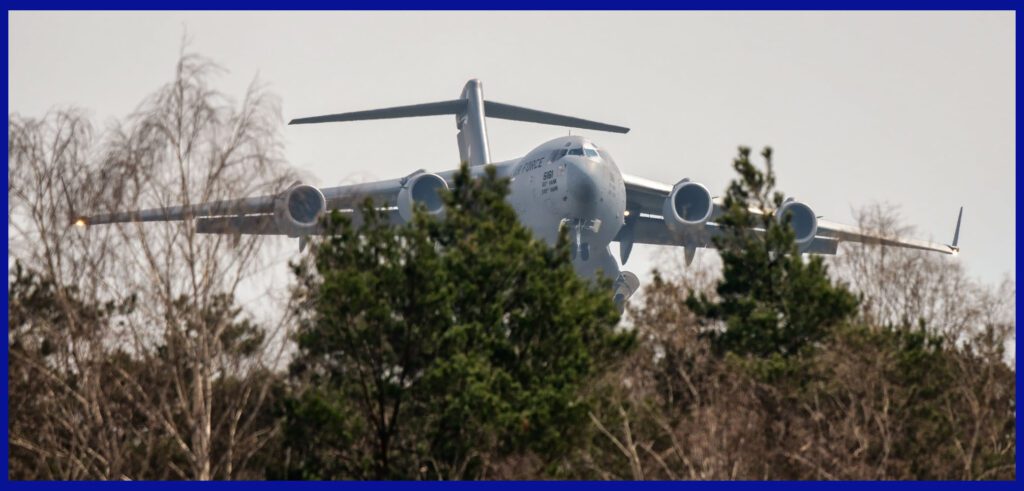
Besides India, Several Other Nations Operating the C-17 Globemaster III Include
- United States Air Force (USAF): The USAF is the largest operator of the C-17 Globemaster III, with a fleet of over 220 aircraft.
- Royal Air Force (RAF): The RAF operates eight C-17s for strategic airlift operations.
- Royal Australian Air Force (RAAF): The RAAF operates eight C-17s for airlift operations.
- Canadian Armed Forces (CAF): The CAF operates five C-17s for strategic airlift operations.
- Qatar Emiri Air Force (QEAF): The QEAF operates four C-17s for airlift operations.
- United Arab Emirates Air Force (UAEAF): The UAEAF operates six C-17s for airlift operations.
- Kuwait Air Force: The Kuwait Air Force operates two C-17s for strategic airlift operations.
- United Kingdom Royal Saudi Air Force: The Royal Saudi Air Force operates five C-17s for airlift operations.
Overall, the C-17 Globemaster III is widely used by several countries due to its exceptional performance, range, and cargo-carrying capabilities.
Notable Accidents Involving the Boeing C-17 Globemaster III As of Now
The Boeing C-17 Globemaster III has had several accidents and notable incidents over the years. In 2010, a C-17 crashed at Elmendorf Air Force Base in Alaska, killing all four crew members on board. The cause of the crash was determined to be a pilot error.
In 2011, a C-17 experienced an engine failure shortly after takeoff from Joint Base Lewis-McChord in Washington State, forcing the crew to make an emergency landing. All crew members on board survived the incident.
In 2016, a C-17 caught fire while preparing to take off from Joint Base Charleston in South Carolina. The aircraft was carrying a cargo of ammunition and pyrotechnics at the time, and the crew was able to safely evacuate the aircraft before the cargo exploded.
Despite these incidents, the overall safety record of the C-17 Globemaster III remains strong. With a history of successful missions and reliable performance, it remains a crucial transport aircraft for military forces around the world.
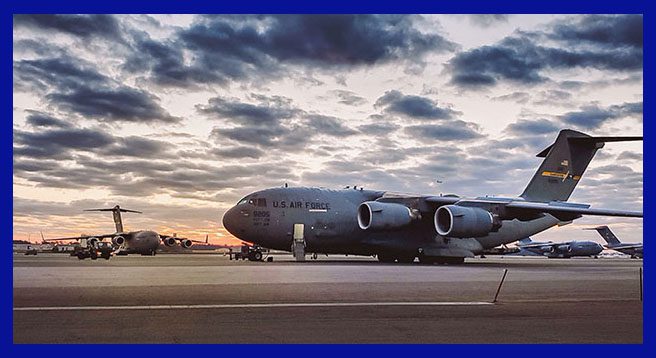
Technical Specifications of the C-17 Globemaster III
- Crew: 3 ( 2 pilots, 1 loadmaster )
- Length: 174 ft ( 53 m )
- Wingspan: 169 ft 9.6 in ( 51.755 m )
- Wing area: 3,800 sq ft ( 350 m2 )
- Height: 55 ft 1 in ( 16.79 m )
- Empty weight: 282,500 lb ( 128,140 kg )
- Max takeoff weight: 585,000 lb ( 265,352 kg )
- Fuel capacity: 35,546 US gal
- Powerplant: 4 × Pratt & Whitney F117-PW-100 turbofan engines, 40,440 lbs ( 179.9 kN ) thrust each
- Cruise speed: 520 mph ( 830 km/h)
- Operational Range: 2,420 nmi (2,780 mi, 4,480 km) with 157,000 lb (71,214 kg) payload
- Ferry range: 7,170 mi ( 11,540 km)
- Service ceiling: 45,000 ft (14,000 m)
- Takeoff run: 3,000 ft (914 m)
- Landing run: 3,500 ft ( 1,067 m ) with maximum payload

“Furthermore, seize the opportunity to acquire a splendid scale model of the C-17 Globemaster III, readily accessible through AirModels. These extraordinary and iconic military transporters, distinguished by their impeccable performance history, are presently accessible for procurement on AirModels, complete with global delivery options. Act promptly by clicking here to secure your piece before the limited stock dwindles.”
In conclusion _ the Boeing C-17 Globemaster III is a highly versatile and reliable aircraft, capable of performing a wide range of missions. It has been a mainstay of several air forces worldwide, including the United States Air Force and the Indian Air Force. Its remarkable capabilities and impressive performance have made it a vital asset in military operations, humanitarian missions, and disaster relief efforts.
With its ability to carry large payloads over long distances, the C-17 Globemaster III has become an indispensable workhorse for air forces across the globe. Despite being retired from production in 2015, the C-17 continues to serve as a critical transport aircraft for the military forces of several nations, and its legacy is likely to endure for many years to come.
Important Announcement for Our Valued Readers!
After an article is published, it is possible that updates or changes may have occurred beyond the time of publication. Therefore, it is important to be aware that certain information in the article might be outdated. To ensure the most accurate analysis, it is highly recommended to verify the content with the latest sources available.
However, we are dedicated to delivering outstanding articles on military products and global updates. Maintaining quality and smooth operation requires resources. Your support sustains our efforts in providing insightful content. By purchasing high-quality products through our affiliated links, you help us keep our platform alive and acquire top-notch items. Your unwavering support is invaluable and inspires us to strive further.
We welcome your suggestions and requests for more information, as we value feedback from our readers. If there’s specific defence material or equipment not covered on our site, please share your request in the comments. We’ll strive to research and provide the required information. We sincerely thank you for your unwavering interest in our website, and we eagerly anticipate hearing from you! Enjoy your reading experience!
